Modern people like to play with mobile phones, watching TV dramas and movies. How long has it been since you went out and sat with people you don't know? How many other people know about operas and dramas? How many classic plays have you seen? Do you make contacts only with fast fading cultures? Are you fully enriched in the inner worlds? Go out and watch the classic plays. Learn from the excellent culture! The author recommends some well-known theatres that you can choose with ease.
I.The National Grand Theater
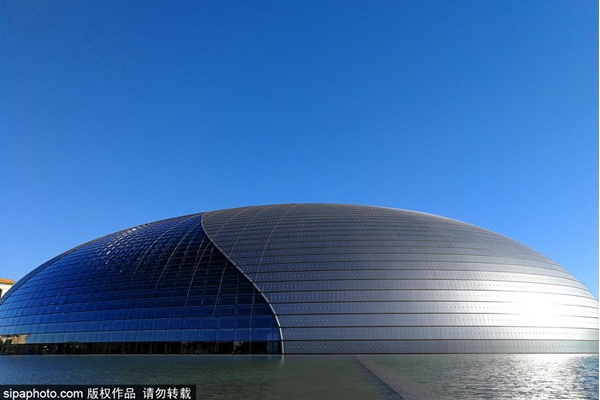
The National Grand Theatre is an important cultural facility as well as a unique landscape resort. It is a landmark building, one of the 16 new Beijing sceneries. The main structure has a unique shape. A clear lake, a large area of green land, trees and flowers around it not only greatly improve the ecological environment of the surrounding areas, but also reflect the concept of harmony and mutual benefit of people and people, people and art, people and nature.
The central building is a semi ellipsoidal steel structure shell, with a long east-west axis of 212.2 meters, a short north-south axis of 143.64 meters, a height of 46.68 meters, the deepest underground of 32.50 meters, and a perimeter of more than 600 meters. The whole style is simple and with great momentum. Its surface is composed of 18398 titanium metal plates and 1226 ultra white transparent glass. The two materials are cleverly spliced to present a beautiful curve, creating the visual effect of the stage curtain slowly opening.
The artificial lake is surrounded by a green belt with a total area of 39000 square meters, which cuts off the noise on Chang'an Street and forms a large cultural and leisure square in the center of the city. The square is free for citizens to enter and roam, providing peace and quietness for the surrounding residents. The design of square follows the idea of introducing the natural garden into the city, which is in harmony with the architecture of the Grand Theatre as a whole, presents the moderate combination of being hidden and obvious, dense and sparse, and integrates the landscape design concepts of multi-layers and communities.
When night falls, through the gradually opening "curtain", the splendid opera house has a panoramic view. On the surface of the shell, there are scattered "mushroom lights", just like the complicated stars, echoing the night sky in the distance, which makes the Grand Theatre full of implicit and unique charm and beauty.
The opera house is the most magnificent building in the National Grand Theatre, with gorgeous golden color as the main color. It mainly performs opera, dance, ballet and large-scale artistic performances. There are 2081 seats in the opera house, including 640 seats in the pool, 584 seats on the first floor, 140 seats on the VIP floor, 717 seats on the third floor, and 126 seats on the music pool. The opera house has an advanced stage with functions of pushing, pulling, lifting, lowering and turning the stage, a tilting ballet stage, a lifting orchestra pit which can accommodate three bands. These world's leading stage machinery and equipment provide a wealth of possibilities for artists' on-site performance. The stage of opera house adopts the form of Chinese character "pin", including main stage, left and right side stage and back stage.
The set can be changed quickly on the stage. The main stage has six lifting tables, which can be lifted as a whole or separately. There are six horizontally movable platforms on the left and right side of the platform. By exchanging positions with the main stage lifting platform, scenes can be changed or participated in performances. A ballet stage is stored 15 meters below the back stage. After the main stage descends, the ballet stage can be moved to the main stage for ballet performance. The opera house is equipped with arc-shaped metal mesh on the wall. The sound can pass through, and the wall behind the metal mesh is polygon, which forms the visual arc and hearing space polygon, achieves the perfect combination of architectural acoustics and theater aesthetics, making the reverberation time reach the perfect 1.6 seconds.
There are many performances in the National Grand Theatre, including concerts, dramas, operas, etc. The performance level is quite high. It's the best choice to watch a performance here at the weekend!
Metro Line: get off at Qianmen station of Metro Line 2
Tel: 8610-66550989
Address: No.2, West Chang'an Street, Xicheng District, Beijing
II.The National Theatre of China

The National Theatre of China is a national art troupe directly under the Ministry of Culture and Tourism of the People's Republic of China. It has rich artistic creation resources and splendid drama cultural traditions. Several generations of drama predecessors, represented by Ouyang Yuqian, Liao Chengzhi, Wu Xue, Shu Qiang, Jinshan and Sun Weishi, have laid a solid foundation for the birth, development, inheritance and innovation of the theatre.
The main task of the National Theatre of China is to create and perform high-quality and high-grade ancient and modern excellent drama works at home and abroad. It is committed to creating high-quality products and focusing on talent training and market development. It is a fertile land for creating Chinese national dramas, a stage for realizing the dream of drama, and a home for countless and hard-working dramatists!
National Theatre of China has three modern theaters, which are suitable for different styles and scales of plays. It takes Beijing as the center and radiates the whole country. At the same time, it strengthens the international drama exchange and cooperation and strives to present the advanced drama culture of the world and the nation to the audience.
The National Theatre of China adheres to the creation concept of "Chinese original, world classic and experimental exploration", sets up lofty artistic ideals, bears the cultural responsibility of drama, firmly adheres to the aesthetic pursuit of the times and scientific management concepts, shapes the national artistic image, and strives to play the role of representative, demonstration and guidance of the National Art Troupe.
There are many excellent plays of the National Theatre, such as "A Life on the Silk Road", "Everything is Miracle", "Jujube Pree", "the prince of Lanling", "The whole Night, Meeting in Sanwan", "Grand Mansion", etc., which is a good place for recreation after work!
Bus route: take No.106, 108, 110, 111, 116, 128, 684, and get off at North of Dongdan Road Crossing Station.
Metro Line: get off at Dongdan station of Metro Line 1 and 5.
Self driving route: 200m north of Dongdan road crossing, and at the west of the road.
Tel: 010-65221009
Address: No.8-2, Dongdan Santiao, Dongcheng District, Beijing
III.The Jingju Theatre Company of Beijing

The Jingju Theatre Company of Beijing is a national key Jingju company with a large scale and an accumulation of art unseen elsewhere. It was founded in 1979 on the basis of merging the Jingju troupes of Beijing – the origin of Jingju – and the troupes of other schools of opera. Currently, it consists of three troupes, a training center, a stage art center, Du Zhenjie Studio and Zhang Huifang Studio.
The elderly generation of artists represented by Mei Lanfang, Shang Xiaoyun, Cheng Yanqiu, Xun Huisheng, Ma Lianliang, Tan Fuying, Zhang Junqiu, Qiu Shengrong and Zhao Yanxia, as the founders of the Jingju Theatre Company of Beijing, have left behind precious artistic and spiritual heritage. Their stage performance, achievements and styles have become distinctive signatures and the sources of artistic inspiration for the Company.
The Jingju Theatre Company of Beijing gathers a big constellation of famous artists. In addition to the above-mentioned elder generation of masters, the Company has many performing artists who have made indispensable contributions to the development of Jingju, such as Wu Suqiu, Li Wanchun, Li Duokui, Zhao Rongchen, Li Zongyi, Li Huifang, Ma Fulu, Jiang Miaoxiang, Li Yuanchun, Wang Yinqiu, Zhou Hetong, Liu Xuetao, Mei Baojiu, Tan Yuanshou, Ma Changli, Mei Baoyue, Zhang Xuejin, Li Yufu, Li Chongshan, Chen Zhiqing, Yang Shaochun, Tan Xiaozeng, Zhao Baoxiu, Yan Guixiang, Wang Yuzhen, Huang Dehua, Ye Jinyuan and Wang Shufang. The famous playwright and litterateur Wang Zengqi, playwrights Wang Yan and Wang Xinji, directors Chi Jinsheng and Xu Chunlan, composers Lu Songling and Zhu Shaoyu, choreographer Zheng Chuan’en, and instrumentalists Li Muliang, Jiang Fengshan, He Shunxin, Wang Benzhen, Yan Shouping, Wang Hewen and Jin Huiwu are all outstanding artists of the Company. The Company boasts a contingent of excellent artists with a wide range of specialties; these talents form an echelon favorable to the Company’s growth. Wang Rongrong, Du Zhenjie, Li Hongtu, Chi Xiaoqiu, Zhu Qiang, Chen Junjie, Zhang Huifang and Hu Wenge are the most influential Jingju artists of today. Bao Fei, Wang Yi, Shang Wei, Zhang Shu, Han Juming, Li Hongyan, Huang Yanzhong, Shen Wenli, Huang Baixue, Mei Qingyang, He Wei, Han Shengcun, Wang Xueqing, Ding Guiling and Zhang Wenjie are the backbone of the Company who carry forward the fine tradition and inspire the new generation of artists. The young performers represented by Zhang Jianfeng, Yang Shaopeng, Du Zhe, Zhang Xinyue, Dou Xiaoxuan, Chang Qiuyue, Jiang Yishan, Guo Wei, Tan Zhengyan, Zhai Mo, Kang Jing, Zhan Lei, Wei Xuelei, Fang Xu, Zhang Shujing, Zheng Xiao, Mu Yu, Wang Yige, Wu Haoyi, Wang Xiaoli, Li Xiaopei, Yu Shuai and Cao Yangyang have become leading Jingju artists of Jingju Theatre Company of Beijing and the country at large. Suo Mingfang, Zhu Hong, Wang Yueling, Chen Zhangxia, Tan Xiaoyu, Lu Yang, Zhang Qian, Ma Botong, Qiu Shi, Bai Jin, Li Jia, Hou Yu, Zhang Kai, Wang Ning and Zhou Meihui among other outstanding young performers have grown into mature artists.
The instrumentalists represented by Ai Bing, Zhao Xu, Shu Jian, Wang Fulong, Zuo Xu, Shen Yuan, Qin Qin, Shi Yingjun, Qiu Xin, Yang Guangtong, Feng Qian, Wang Wei and Liu Yang make the instrumentalist team into another spotlight of the Jingju Theatre Company of Beijing. Relying on a proud tradition, the Jingju Theatre Company of Beijing is good at staging classic Jingju. Still, it keeps launching new plays which combine Jingju art with contemporary themes.
Over the past decades, the Jingju Theatre of Beijing Company has staged and created hundreds of Peking Operas, including the traditional, modern, newly-crafted, and small theatre ones.
The classic repertoire includes over 200 plays, such as “Harmony Through a Royal Marriage”, “Silang Visiting His Mother”, “The Chinese Orphan”, “Mu Guiying Taking Command”, “Red-mane Savage Horse”, “The Female Generals of the Yang Family”, “Guarding the Nation”, “Visiting the Royal Tomb and Entering the Palace for the Second Time”, “An Embroidered Treasure Pouch”, “Gathering of Heroes”, “Borrowing East Wind”, “The Pearl Shirt”, “Stepmother Admonishes the Son”, “Lü Bu and Diaochan”, “Pearl-curtain Village”, “Jin Yunu”, “The White Snake Legend”, “Yu Tang Chun”, “Qin Xianglian” and “Ten Figures against Lv Zhi”.
Modern Jingju include “Shajia River”, “Azalea Mountain”, “The Legend of the Red Lantern”, “Taking Tiger Mountain by Strategy”, “The Song Sisters”, “Mei Lanfang”, “Above the Cloud”, “Qiu Shengrong” and “The Daughter of the Party”.
The newly-crafted historical Jingju include “The Finishing Touch”, “Vicissitudes of Tongrentang”, “Prime Minister Liu”, “The Goddess of the Luo River”, “Empress Wu, To Lucheng”, “Unexpected Promotions”, “Yuan Chonghuan”, “Qu Yuan” and “Zhengkaofu”.
The Jingju Theatre of Beijing Company has taken the lead in turning out small theatre plays. It has launched more than small theatre plays that win wide acclaim among the opera community as well as the audience, like “A Foregone Marriage”, “Three Sinners”, “Story of the Jade Hairpin”, “Six Records of a Floating Life”, “The Salvation of the King Zhao of Chu”, “Xi Jiao”, “Jade Grinding Guanyin”, “Srping Banquet”, “Something about the Ming Dynasty: Interrogating the Head and Assassinating Tang Qin” and “Wu Qi”.
Metro Line: get off at Jiaomen East Station of Metro Line 10, and exit B (northeast entrance).
Tel: 010-672477775
Address: No.30, Haihuxili, Fengtai District, Beijing.
IV.Chang'an Grand Theater
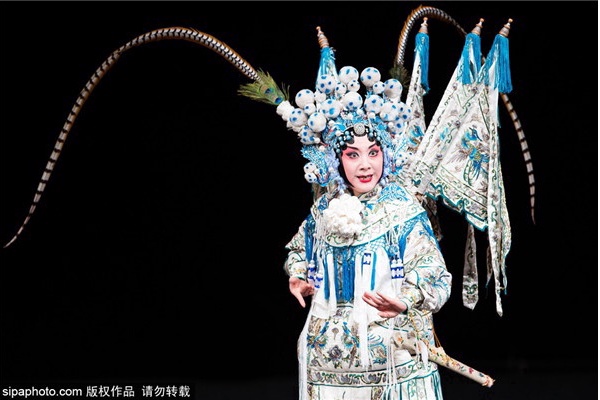
It is located in Guanghua Chang'an Building. The front of the building adopts the fashionable sapphire blue glass appearance, and the top floor imitates the gold colored glazed tiles, retaining the traditional style of Chinese palace architecture. Just in front of the building stands a Beijing Opera Face Art Statue, simple and vivid. With its unique geographical location, it continues its glorious history, carries the responsibility of carrying forward national traditional culture, and affects the hearts of new and old audiences at home and abroad.
In addition to the teahouse in the front area, there are row seats in the back area. On the second floor, there are VIP box, ordinary box and row seats. On the second floor of the lobby, there are still photos of the old generation of performing artists and costume display cabinets of Peking opera; on the first floor, there are masks, calligraphy and painting, and audio-visual products for sale. The theater is spacious, bright and magnificent. All the halls are inlaid with Italian natural marble. The escalator can directly send the audience to the second floor auditorium. The hall is equipped with exhibition and sales stands for traditional Chinese paintings, folk arts and crafts and antique replicas. The audience hall can accommodate 800 people, with simple, elegant and national style interior decoration. There are 26 mahogany tables and 130 mahogany chairs in the front area of the first floor of the theater, where the audience are served with high-grade tea sets, tableware and foods specially made by Chang'an Grand Theater. The traditional ethnic culture is full of charm.
One of its biggest characteristics is that in order to let foreign tourists understand and appreciate Peking opera, Chang'an Grand Theater cooperates with other organizations to arrange operas more suitable for tourists to watch. These are carefully choreographed by the writers and directors. They contain all the roles of Peking Opera as much as possible, and they are understandable to the audience. Many foreign guests praised the Peking Opera "Legend of White Snake" launched in 1997. Its evening special performance of Peking Opera for tourists every day is a feature in the field of Peking opera in Beijing
Chang'an always adheres to the tenet of "Chang'an can't do without Peking Opera, but Chang'an can't perform Peking Opera only". To a large extent, it retains the folk classic repertoire, which is staged regularly to meet the audience's viewing requirements and taste. At the same time, a variety of art forms are combined to attract young people and children. In recent years, the theater has been seeking new breakthroughs, performing and producing more classic and excellent plays. On the basis of preserving the original feature of the opera, these plays seek to reflect the cultural atmosphere changing with the times, so that more experts and audiences can conduct academic exchanges through its stage, and it becomes an art paradise for people at home and abroad to pay attention to traditional Chinese folk opera and appreciate Beijing opera.
There are many classic repertoires in the theater, such as "Zhuangyuan Mei", "Hong Niang", " Mu Guiying Taking Command", "The Chinese Orphan", etc. People who love Peking opera don't miss it!
Metro Line: Jianguomen station, exit A of line 1 and line 2
Tel: 010-51664621
Address: No.7, Jianguomennei Street, Beijing
V.Forbidden City Concert Hall
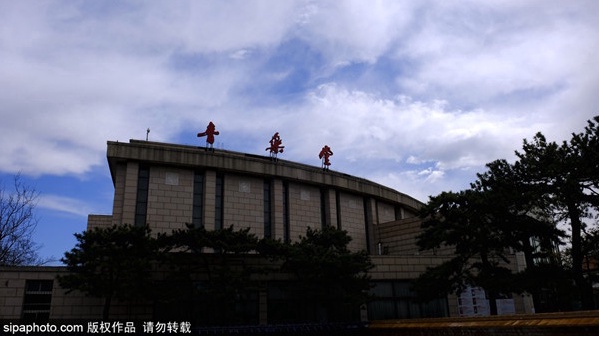
Forbidden City Concert Hall is adjacent to the Forbidden City in the east and Tian'anmen Square in the south. Zhongshan Park, where the music hall is located, formerly known as "the altar of state", is a part of the Forbidden City. Therefore, the music hall is known as "the pearl of music in the royal garden of China" by musicians at home and abroad. The unique charm of this music hall are endowed by its superior geographical location and humanistic environment.
Forbidden City Concert Hall was built in 1942, which has been more than half a century. In 1997, the Beijing Municipal Party Committee and the Beijing Municipal Government spent a lot of money to rebuild the music hall. In April 1999, the newly built music hall was presented as a professional classical music hall with elegant sound effect to Beijing people.
The stage of Zhongshan Park Music Hall is 23 meters wide and 14 meters deep. The rear area of the stage is equipped with a four-story lifting platform, and the front area is equipped with a piano lifting platform. The American Austin organ is installed at the back of the stage. There are 1419 seats in the auditorium, which are divided into two layers. There are 833 seats on the first floor, including 5 boxes and 41 seats, and 586 seats on the second floor. In addition, the concert hall also has a small movie hall with excellent facilities, which can accommodate 150 people, a conference hall with a capacity of 200 people and a luxury VIP hall with a capacity of 60 people.
The concert hall is the main venue of China Philharmonic Orchestra and Beijing Symphony Orchestra, two famous orchestras in China, as well as the main performance venue of Beijing International Music Festival. Every year, it performs more than 200 wonderful programs such as western classical music, jazz, world music, modern dance, Chinese traditional folk music and opera, among which "flourishing music and culture week", "opening the door of art", "French piano festival", "Jiumen jazz festival" and other brand programs are deeply popular.
Metro Line: take line 1 and get off at Tiananmen west station, exit from B (northeast)
Tel: 010-65598285
Address: Zhongshan Park, West Chang'an Street, Beijing
VI.National Peking Opera Company
Established in January 1955, China National Peking Opera Company (CNPOC) is one of the national ensembles of performance arts directly under the Ministry of Culture, People's Republic of China. The first President of the Company is the Peking Opera master Mei Lanfang. The company consists of Group One, Group Two, Group Three, Stage Art Center, Creation and Research Center, Marketing and Promotion Department, Mei Lanfang Grand Theatre and so on.
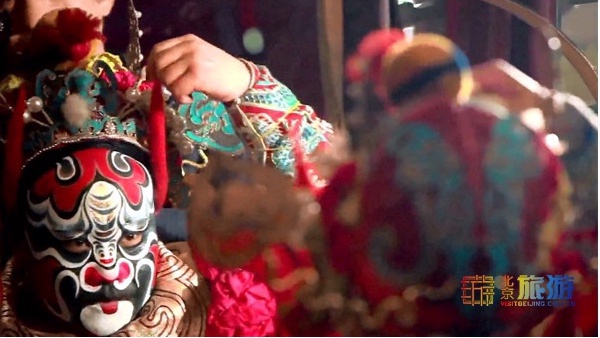
Since its founding, the company has brought together a large number of outstanding performing artists and playwrights, directors, composers and stage artists, who enjoy a high reputation both at home and abroad, such as Li Shaochun, Yuan Shihai, Ye Shenglan, Du Jinfang, Weng Ouhong and Fan Junhong, Ajia, Zheng Yiqiu and Liu Jidian, etc. With a galaxy of masters, CNPOC has grown into a performing organization of Peking Opera with competitive strengths.
For 60 years, CNPOC has inherited, created, and staged more than 500 traditional, new-style historical and modern Peking Opera plays with various themes and forms. It upholds an art spirit of inheritance, innovation, being ready to learn from other artistic forms and good at portraying characters. Moreover, it has created an artistic style featuring rich contents, profound thoughts, novel stage design, various schools, and the well-balanced cast. The repertoire of CNPOC includes “Wild Boar Forest”, “Three Attacks on Zhu’s Manor”, “Lv Bu and Diaochan”, “the Legend of the White Snake”, “Under Willows – Liang Shanbo and Zhu Yingtai”, “Poyang Lake”, “Xie Yaohuan”, “On the Crossroad”, “Mu Guiying Taking Command”, “Havoc in the Heavenly Kingdom”, “All Red is the River – A Patriot Wronged”, “Women Generals of the Yang Family”, “The Red Lantern”, “Fighting on the Plains”, “Red Women Soldiers”, “Chuncao Breaking in the Court”, “Yang Kaihui”, “Sister Jiang”, “Princess Wencheng”, which enjoy huge popularity among the audience.
Metro Line: get off at Ping'anli station of line 4
Tel: 010-58519688
Address: No.22, West Pinganli Street, Xicheng District, Beijing
VII.China National Theatre for Children (CNTC)
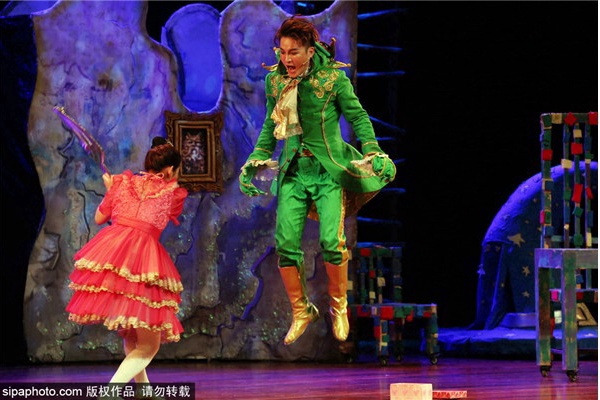
Founded in 1956, China National Theatre for Children (CNTC) is the only national children's art troupe directly subordinated to the Ministry of Culture and Tourism of the People's Republic of China. “All for children” is the permanent goal of CNTC.
Borne the responsibility of inheriting, developing, creating and presenting excellent theatrical performances for the youth, CNTC played an important role in representing, demonstrating and guiding in national children's drama. For more than half a century, CNTC has dedicated numerous classic and diverse dramas for the audience. Numbers of outstanding artists and performers from CNTC have been highly awarded for artistic contribution in China and the world.
Over the past decades, CNTC has created and performed many excellent theatrical works at home and abroad, such as “Malan Flower”, “Family of Revolutionaries”, “The Young Guards”, “Here is the Yard”, “The Moonlight Lullaby”. Plays written and performed in recent years include “The Little Tadpole Looks for its Mummy”, “The Dragon Child”, “Journey to the West”, “Pippi Long Stocking”, “The Snow White and the Seven Dwarfs”, “Little Tin Kid”, “Little Jeep”, “Three Little Pigs”, “Little Prince”, “The Frog Prince”, “The See-Saw Tree”. Their shows have been toured in all provinces of China, more than 20 countries on five continents in the world, and built national and international reputation.
The large venue called ‘China Children Art Theatre’ was named and inscribed by Soong Ching-ling, the former honorary chairman of the People's Republic of China. In 2005, a new studio theatre called ‘Holiday Classic Theatre’ was opened on CNTC building’s fourth floor. Every week, the two theatres are cross-echoed with classic children dramas presented to the audience. It has become the ‘Art Palace’ of children’s drama in modern China.
It's extremely suitable for parents to bring their children here~
Metro Line: Line 1, Wangfujing Station, exit C2
Tel: 8610-65134115
Address: No.64, Dong'anmen Street, Dongcheng District, Beijing
VIII.Beijing People's Art Theatre
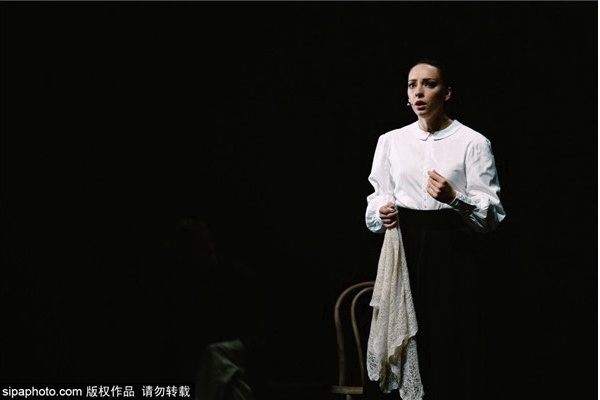
Beijing People’s Art Theater (BPAT) is a specialized modern drama theater with unique performing styles. It was established in June 1952, with Cao Yu, a renowned dramatist of China, as the first Director. The current Director is Ren Ming. As the most renowned specialized modern drama theater in China, in the artistic development of 60 years, BPAT has established vivid performing styles. With long-term accumulations of artistic practices and aesthetic theories and based on the connotations of realism and nationalization, experience and reproduction of drama aesthetics, the “Beijing People’s Art Theater School” has been created with consummated integration of all aspects.
Ever since the establishment, BPAT has offered over 300 dramas at all times and in all over the world. In the 1950s and 1960s, the Theater gained reputations by performing dramas written by Guo Moruo, Lao She, Cao Yu and Tian Han. Representative works include domestic dramas such as “Dragon Beard Ditch”, “Tiger Tally”, “Cai Wenji”, “Empress Wu Zetian”, “Tea House”, “Rickshaw Boy”, “Thunderstorm”, “Sunrise”, “Peking Man” and “Guan Hanqing” as well as foreign dramas such as “The Miser”, “Aesop” and “Even Homer Sometimes Nods”. Mr. Jiao Juyin, a renowned dramatist of China, once served as Chief Director of the Theater. In artistic practices over the years, the Theater has cultivated numerous performing artists represented by Yu Shizhi, Diao Guangqin, Shu Xiuwen, Tian Chong, Zhu Lin, Tong Chao, Zheng Rong, Lan Tianye and Dong Xingji.
Since the 1980s, the Theater has performed over 100 dramas, of which several dramas have been performs for several sessions. And a great number of dramas have been awarded the Wenhua Award, Five-One Project Award, etc. Major dramas involve “Wang Zhaojun”, “Absolute Signal”, “Small Well Hutong”, “Weddings and Funerals”, “Uncle Doggie’s Nirvana”, “No. 1 Pavilion in the World”, “Li Bai”, “Birdman”, “The First Intimate Contact”, etc. Major foreign famous dramas involve “A Noblewoman Returning Hometown”, “God's Favorite”, “Death of a Salesman”, “The Gin Game”, “Mutiny”, “Butcher”, etc. A great number of talented actors have emerged from BPAT, including those still active in modern stages such as Pu Cunxi, Liang Guanhua, Yang Lixin, Song Dandan, Feng Yuanzheng, He Bing, Xu Fan, Chen Xiaoyi and Hu Jun.
In recent years, the Theater has further introduced a series of impressing and excellent dramas, such as “Twinkling Lights”, “North Street and South Courtyard”, “Chinese Orphan”, “I Love Peach Blossom”, “Happy Family”, “White Deer Plain”, “Peking Man”, “Major General Kou Liulan”, “Hamlet”, “Bosom Friend”, “Steam Corn-bread Hall”, “Comic Sorrow”, “Our Jin Ke”, “Home”, “The Death of A Salesman” and “Jiazi Garden”.
Presently, Beijing People’s Art Theater operates two theaters for performance, which respectively are the Capital Theater, Experimental Theater. Every year, as many as 240,000 audience step into the theaters to enjoy the dramas.
Metro Line: Line 1, Wangfujing Station, exit C2.
Tel: 010-65246789
Address: No.22, Wangfujing Street, Beijing
IX.Mei Lanfang Theatre
Beijing Meilanfang Theatre is located in the southeast corner of Guan Yuan Qiao. It is a modern performing place named after Mr. Meilanfang, the master of Peking Opera Art in China, which combines traditional and modern art perfectly. The Theatre is affiliated to China National Peking opera academy, covering an area of more than 13000 square meters. It has five floors above the ground and two floors below the ground. There are 980 audience seats. It has various functions such as performance, exhibition, conference, audio-visual recording, etc. It is also the first choice for social gathering.
The whole theater is wrapped by transparent glass curtain wall. Through the bright glass, you can see a royal red wall. Every night, like a piece of red crystal, the red wall glitter in the embrace of two skyscrapers. The external structure of the Theatre embodies the modern design concept. The fan-shaped steel frame combined with glass constitutes a dynamic structural equilibrium system, forming a smooth, vivid and musical building. The interior decoration of the Theater has integrated the essence of China's traditional architectural form. The red pillars, the red walls, are inlaid with ten golden wooden circular engravings, each of which has solidified and reshown the essence of Peking Opera having been inherited for 200 years. From a distance, it is like an art gate open to the world, which conveys the profound cultural heritage of this historical city and the inclusiveness of Peking Opera Art.
Kunqu Opera is often performed in the theater, such as "the Jade Hairpin", "the White Rabbit", "the West Chamber", "Peony Pavilion", etc. Those who like Kunqu Opera can pay attention to it!
Metro Line: get off at Chegongzhuang station of Metro Line 2
Tel: 010-58331288
Address: No.32, West Pinganli Street, Xicheng District, Beijing
X.Beijing Liyuan Theater
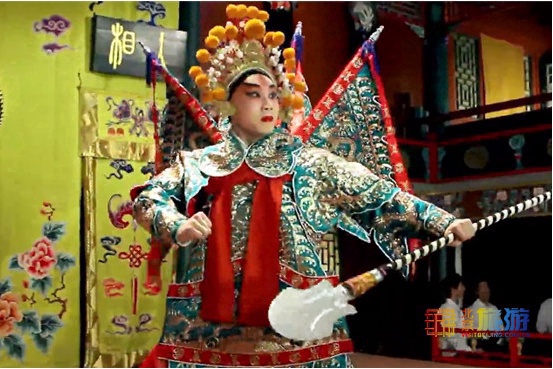
Liyuan Theater is the first teahouse theater in Beijing, including Baxian table, Gaiwan tea, Beijing snacks and Peking Opera. Except the eve of Spring Festival, Beijing Opera is on every day here.
Every night, Chinese and foreign tourists gather here to eat Beijing snacks, drink tea, listen to Beijing Opera and experience the life of "old Beijing". Here you can also watch actors’ making-up, take photos with actors, or even try on Peking Opera clothes and make-up, providing guests with a full range of unique experiences.

This is a performance venue jointly run by Jianguo Hotel and Beijing Peking Opera Company. With Peking Opera as the carrier, it has built a stage for Peking Opera to show to the worlds. On this stage, many Peking Opera masters have shown their faces, and also trained and brought along generations of new Peking opera artists. It has been the "best place for evening activities" of Beijing Tourism Forbidden Cup for 13 consecutive years. "Climbing the Great Wall, eating roast duck and watching Peking Opera" has now become a "compulsory course" for foreign tourists to Beijing. According to statistics, one out of every ten foreign tourists to Beijing has come to "Liyuan Theater" to see Peking opera.
The daily performances are different. Please check the official website. Those who like to watch Beijing opera, remember to book tickets~
Metro Line: get off at Caishikou station of line 4
Tel: 010-65524990
Address: Floor 1, Qianmen Jianguo Hotel, No.175 Yong'an Road, Xicheng District, Beijing
XI.China Pingju Theater
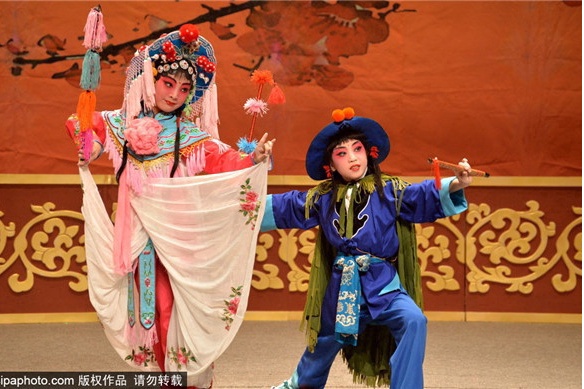
The China Pingju Theater, which was built in 1999, is a cultural building standing in the south part of Beijing. It's a standard opera theater built according to the principle of "one group, one place, one place".
China Pingju Theatre includes grand theatre, small theatre, multi-functional hall and rehearsal hall. It is equipped with a stage with complete functions, complete performance facilities, excellent audio-visual effect and comfortable and elegant environment. There is an independent parking square and a garden for resting, close to Beijing South Railway Station, located between the second and third ring road in the south, with convenient transportation and travel. The theatre has held nearly 100 kinds of plays, including Pingju, Huangmei opera, Yu opera, Yue opera, Lv Opera, Qin opera, Jin opera, etc., more than 160 performing troupes and more than 2000 performances.
"National Modern Opera Research Association" is set up here, which provides very convenient conditions for inviting audience, drama review, actor comment, publicity and promotion, and is an ideal choice for local opera troupes to show their style and charm.
Metro Line: Line 4, Beijing South Station
Tel: 010-87266331
Address: No.19, District 4, Xiluoyuan, Fengtai District, Beijing
XII.Poly Theatre
Poly Theatre has 62 first-class theaters in China, with over 100 auditoriums and over 100000 seats. In the past 14 years, the Poly Theater has performed 43000 plays and received more than 45 million audiences.
Many famous experts gathered here. Internationally, the world's top ten symphony orchestras has come to Poly Theatre, represented by London Philharmonic Orchestra, Berlin Philharmonic Orchestra, Vienna Philharmonic Orchestra and many other world-class performances, such as Jos é Carreras World Farewell Concert. They has successively introduced classic musicals from Broadway and Eest End of London, such as “Cats”, “Notre Dame de Paris”, “Winnie the Pooh”, “Ghost”, and “The Bodyguard”. At home, famous drama directors Lai Shengchuan, Meng Jinghui, Lin Zhaohua and others have brought many classic drama works to Poly’s audiences, such as “A Dream Like a Dream”, “Amber”, “A Midsummer Night’s Dream”. Many famous works have also brighten the Poly’s stage, such as Yang Liping's “Dance Peacock”, Central Ballet's “Red Detachment of Women”, Beijing People's Art Theatre’s drama “Teahouse” and “The Top Restaurant”, Taiyuan Dance Company's dance “Thousand Hands Guanyin”.
Singer Li Jian once held a concert here~
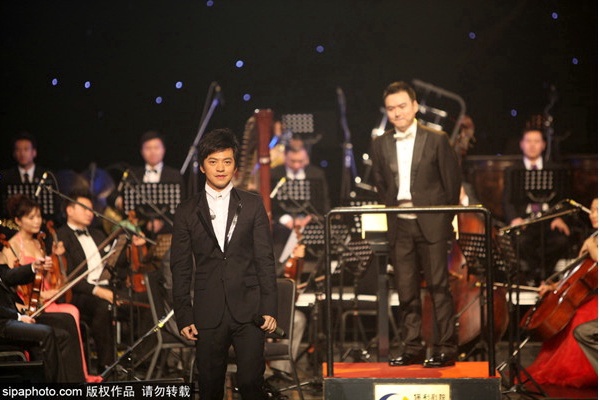
Metro Line: get off at the East Sishitiao of Metro Line 2
Tel: 010-65001188
Address: No.14, South Dongzhimen Street, Dongcheng District, Beijing
XIII. Beijing Huguang Guild Hall
Founded in 1807, Beijing Huguang Guild Hall is located in the southwest corner of Hu Fang Bridge, Xicheng District. To the east is Hufang Road; to the north is Luomashi street; to the south is Beijing Workers' Club; to the west is residential area. The current address is No. 3, Hufang road. This building presents not only the resplendence of the Imperial Palace, but also the exquisitition of palaces of princes’. Huguang Guild Hall is a guild hall established by the people from Hunan and Hubei provinces to contact the villagers. It is mainly used for gatherings of fellow countrymen. It has a history of 200 years. It is one of the only famous guildhalls with theatrical buildings in Beijing. It is also the first guild hall restored according to the original pattern and opened to the public.
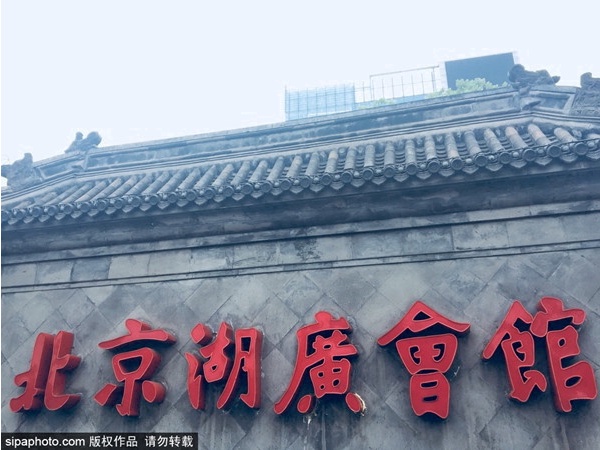
The original site of the guild hall used to be the former residence of senior executives in the Qing Dynasty. According to historical records, the ministers of Qianlong and Jiaqing lived here, such as Liu Quanzhi and Wang Jie. Dr. Sun Yat Sen, the great revolutionary of China, came here five times, and held the first meeting of the Kuomintang here. Since then, he has held many inner-party meetings here. Many famous performing artists have performed here, such as: Tan Xinpei, Chen Delin, Wang Zhijun and so on. Huguang Guild Hall has a glorious history, but after a hundred years of ups and downs, it has gradually lost its original luster and became dilapidated. In order to protect the precious heritage resources left by our ancestors, in May 1984, the People's Government of Beijing announced that Huguang Guild Hall is a cultural relic protection unit of Beijing. Its value has been further confirmed. In December 1986, Zhang Kaiji, member of the Standing Committee of the Beijing Municipal Committee of the CPPCC and chief architect of the Beijing Architectural Design Institute, put forward a proposal to restore the Huguang Guild Hall as a Theatre Museum. This proposal received the attention of relevant leaders, and then a decision was made to restore the Huguang Guild Hall in Beijing. After long-term efforts of people from all walks of life, the restoration project was finally completed in April 1996.
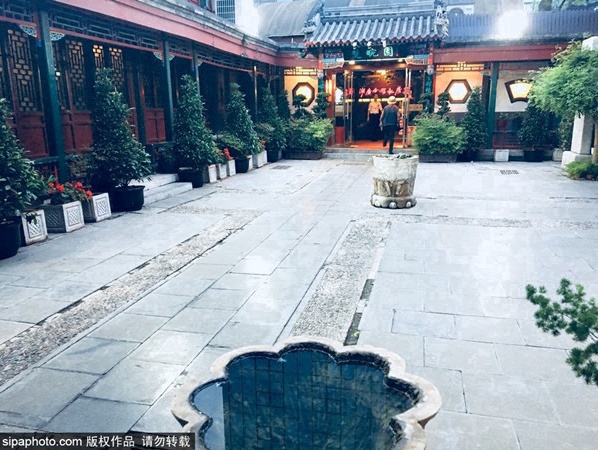
On May 8 of the same year, Beijing Huguang Guild Hall was officially opened to the public. After restoration, the guild hall is full of cultural atmosphere. The auditorium is divided into upper and lower floors. The Baxian table is arranged in order to provide a comfortable environment for the audience. The rebuilt guild hall maintains the original architectural style. The overall building is simple, elegant, spacious, and with its unique appearance, which has become a beautiful landscape in the south city of Beijing. After a long time of cultural relics collection, on September 6, 1997, the Beijing Huguang Guild Hall was founded and announced as "Beijing Opera Museum", the 100th museum in Beijing.
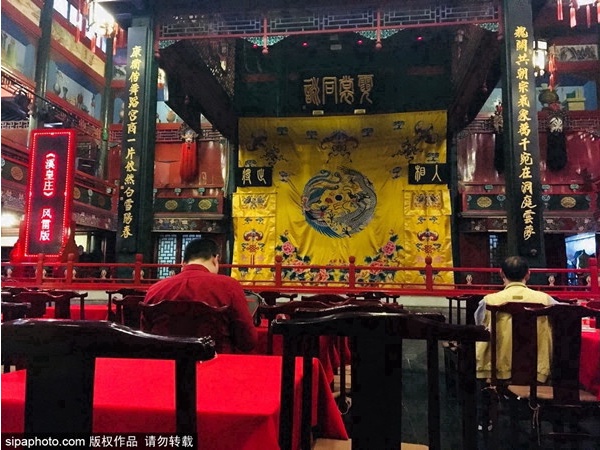
At present, the Beijing Huguang Guild Hall is composed of "Opera House", "Wenchang Pavilion", "Baoshan Hall" and "Humanities Hall". There is a well in front of the museum called "Ziwu well", which is called "Ziwu well" because according to historical records, the water drilled from the well is extremely sweet at midnight (zero), and noon (12 noon), while the water in other wells is bitter at other times. There are two steles on both sides of the well, written by Shi Huibao and Xu Lanyuan respectively, which record the process and the amount of donations of Liyuan predecessors’ buying Yiyuan (tombs) for poor colleagues. So far, the Guild Hall has gone through nearly ten years after restoration.
Today, Huguang Guild Hall is more magnificent after repair. The sculpture on the square in front of the gate is full of the time flavor of national culture. The newly built screen wall facing the gate adds more dignity. The restored hall provides an oriental classical theater for tourists at home and abroad. Today, it has become a tourist attraction with ancient capital features, integrating sightseeing, catering and shopping.
With the rapid development of market economy, Huguang Guild Hall is also following the pace of the times. While improving the hardware facilities, the Hall are also constantly improving the work flow and service, gradually reaching the international level. As a cultural relic, Huguang Guild Hall symbolizes the long history of Chinese history and culture, as well as the combination of the ancient and modern style of the capital. It is a special and beautiful landscape of the capital.
At present, Deyun Club performs regularly in Beijing Huguang Guild Hall. Tickets for performances need to be booked online through Damai or purchased on site. Come to Huguang Guild Hall to enjoy the cross talk. It’s more than the cross talk, but also experience its history of one hundred years and the generosity of Liyuan predecessors.
Metro Line: get off at Hufangqiao station of Metro Line 7.
Tel: 010-63518284
Address: No.3-1, Hufang Road, Xicheng District, Beijing
XIV.Sanqing Theatre
Beijing Sanqing Theatre has a history of 220 years. Sanqingban, one of the four major Hui classes, regards this as the primary place of choice to perform.
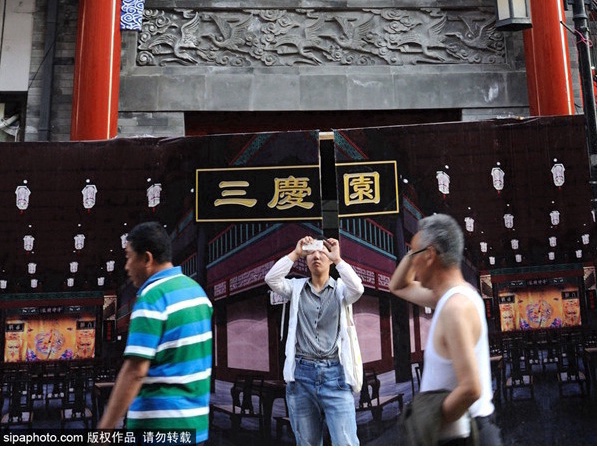
It was temporarily closed down in 1950 due to construction safety problems, and has been used as a business place since then. In 2013, the reconstruction project of Sanqing Theatre was officially launched. After reconstruction, the building area here is about 1600 square meters, with traditional seats and boxes, which can accommodate more than 200 people. With modern lighting and audio equipment, the environment is elegant, and the stage is glorious, which can fully meet the audience's audio-visual art enjoyment.
Deyun Club performs regular performances here. Selling tickets for the next week from every Friday, which can be booked by phone or purchased online through Damai. Tickets for the show are very popular. If you are into it, you’d better book your tickets early~
Metro line: get off at Zhushikou of line 7
Tel: 010-66552122
Address: No.18, Dashilan Street, Xicheng District, Beijing
XV.Deyunshe Theater
Deyunshe Theatre is located at the birthplace of Beijing folk art –Tianqiao. It was founded in 1933 as "Tianle theater", and reopened in 1992 after reconstruction. Here visitors can enjoy Beijing folk culture and enjoy the past hustle and bustle again.
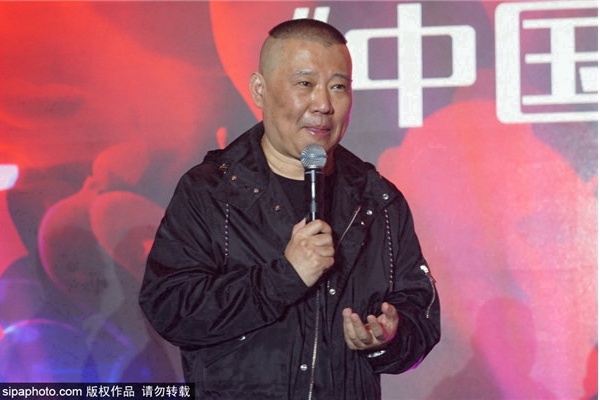
With a total construction area of 1300 square meters, it can receive more than 300 people to watch plays, eat and taste tea at the same time. There are 40 tables in the hall on the first floor, with elegant environment and comfortable seats; there are 9 boxes on the second floor, with unique characteristics and traditional national architectural style. Actors and waiters dressed in folk costumes are integrated in traditional environment of the lobby. The stage of Deyunshe Theatre is composed of opera, acrobatics, martial arts and quyi. The program is wonderful, which makes the audience immersed in the atmosphere of Beijing folk traditional culture.
Founded in 1996 by crosstalk actor Guo Degang, Beijing Deyunshe is a performance group with the main purpose of promoting national culture, cultivating talents of quyi and serving the public. Beijing Deyunshe mainly promotes the national culture and spreads the traditional culture and folk art to the public with the theater as the carrier. It lets crosstalk art return to the theater and survive and create a new bright spot for Beijing performance market. Every day, the performance is wonderful and continuous. With low ticket price and high-quality service, it attracts Chinese and foreign tourists and make them understand the ancient capital culture and feel the modern style.
Metro Line: take metro line 7, get off at Zhushikou station
Tel: 010-66552122
Address: A1, Beiwei Road, Xicheng District, Beijing
There are so many excellent theatres in Beijing that you don't have to worry about places to go on weekends!



